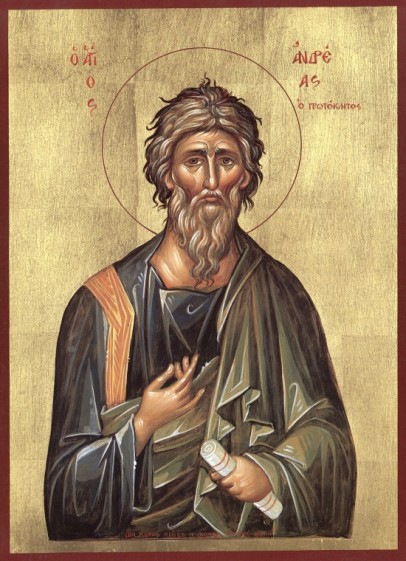Andrew the Apostle

Andrew the Apostle, also known as First-Called, was one of the first disciples of Christ in Christian tradition.
He was born in Galilee, Bethsaida. According to Mark 13:3, he is mentioned with Simon-Peter, James, and John. Since the 11th century, Andrew has been know in Georgia as the first evangelizer and disseminator of Christianity among Georgians.
The first mention of his activities in Georgia is attributed to Niketas Paphlagon (763-838). His work refers to Andrew as an enlightener of Iberians, Sauromatians, Taurians, and Scythians.
George the Hagiorite (second half of the 11th century) writes about Andrew’s work in Georgia. He claims that Andrew was the founder of the Georgian church. Furthermore, he argued with the patriarch of Antioch to give the Georgian church independence.
Georgian tradition claims that on his way to Georgia, Andrew traveled through Trapizon, "which was the village of the Megrelians", from there he continued his journey to the land "called the land of the Great-Ajara (Did Achara)". It is mentioned that he traveled through Klarjeti and Samtskhe, where he planted an iron cross on a mountain and created a toponym that is used to this day (i.e. Jvari). Andrew then continued his journey to Zaden-Gor village, where he destroyed pagan idols with the power of the icon. In Meskheti he converted Samdzivari, a widow of a local Didebuli (nobleman), to Christianity. Furthermore, he demonstrated the strength of the Icon of the Mother of God; with its power, he destroyed the idols of Artemis and Apollo. He then traveled through Svaneti, walked across the entire Abkhazia, and finally reached Jiketi.
Andrew was martyred. According to tradition, he died bonded to the tree. According to other traditions, he was crucified like his brother. However, the cross he was crucified on had a different shape (afterward it was referred to as Saint Andrew's Cross). According to tradition, he was not silent on the cross and continued preaching for four days. Because he was not nailed to the cross, he died in pain. According to Jerome, in 357, Constantine II, had the body of Andrew transferred from Patras (the place of his martyrdom) to Constantinople. The orthodox church commemorates St. Andria the First-called (November 30th), i. e. the same day of his final glorification
Sources: ახალი აღთქუმაჲ უფლისა ჩუენისა იესო ქრისტესი, მათე, 4. 18; 10, 2; მარკოზი, 1, 20; 3, 18; 13, 3; ლუკა, 6, 14; იოანე, 1, 14; 1, 40; 1, 44; 6, 8; 12, 22, თბ., 1963; ქართლის ცხოვრება, ს. ყაუხჩიშვილის გამოც., ტ. 1, თბ., 1955, გვ .38–42
Literatre: ჯავახიშვილი ივ., ანდრია მოციქულის და წ-ა ნინოს მოღვაწეობა საქართველოში, «მოამბე», 1900, № 6.
Z. Kiknadze


